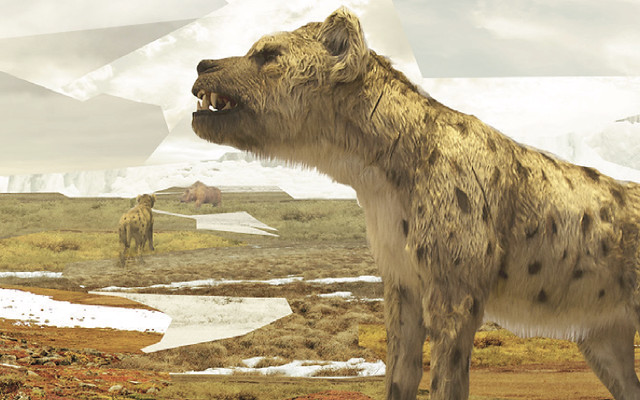The cave hyena (Crocuta crocuta spelaea), also known as the Ice Age spotted hyena,[1]was a paleosubspecies of spotted hyena[2] which ranged from the Iberian Peninsula to eastern Siberia.[3] It is one of the best known mammals of the Ice Age and is well represented in many European bone caves.[4] The cave hyena was a highly specialised animal, with its progressive and regressive features being more developed than in its modern African relative.[5] It preyed on large mammals (primarily wild horses, steppe bisonand woolly rhinoceros), and was responsible for the accumulation of hundreds of large Pleistocene mammal bones in areas including horizontal caves, sinkholes, mud pits and muddy areas along rivers.[1]
The cause of the cave hyena’s extinction is not fully understood, though it could have been due to a combination of factors, including climate change and competition with other predators.[6][7]
The European cave hyena was much larger than its modern African cousin, having been estimated to weigh 102 kg (225 lb).[8] In Late Pleistocene specimens from Europe, the cave hyena’s metacarpals and metatarsals are shorter and thicker, while the humerus and femur are longer,[4]thus indicating adaptations to a different habitat from that of the modern spotted hyena.[9] As with the African subspecies, female cave hyenas were larger than their male counterparts.[1] Paleolithic rock art depicting the cave hyena shows that it retained the spotted pelt of its African relative.[10]
Several den sites found in Europe indicate that the cave hyena preferentially targeted large prey, with wild horses predominating, followed by steppe bison and woolly rhinoceros.[1][11][12] The cave hyena’s favouring of horses is consistent with the behaviour of the modern African spotted hyena, which mostly hunts zebras. Secondary prey species included reindeer, red deer, giant deer, European ass, chamois and ibex.[1] A small number of wolf remains have also been discovered in hyena den sites. The cave hyena likely killed wolves due to intraguild competition, though their presence in the cave site indicates that they were also fed upon, which is unusual among carnivores.[12] Similarly, cave lion and bear remains have been discovered in hyena den sites, thus indicating that hyenas may have scavenged on or killed them.[1]
(From Wikipedia, May 2018)




